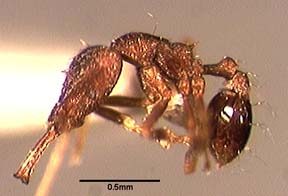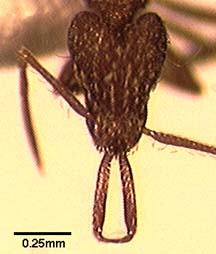
Specimen: Costa Rica, Prov. Heredia: 17km S. Pto. Viejo, 550m (J. Longino 1088-s). INBIOCRI001284007. Image by J. Longino.

Specimen: Costa Rica, Prov. Heredia: 17km S. Pto. Viejo, 550m (J. Longino 1088-s). INBIOCRI001284007. Image by J. Longino.
Dacetini, Myrmicinae, Formicidae, Hymenoptera, Insecta, Arthropoda, Animalia
John T. Longino, The Evergreen State College, Olympia WA 98505 USA.
15 April 1997
Specimen: Costa Rica, Prov. Heredia: 17km S. Pto. Viejo, 550m (J. Longino 1088-s). INBIOCRI001284007. Image by J. Longino. |
Specimen: Costa Rica, Prov. Heredia: 17km S. Pto. Viejo, 550m (J. Longino 1088-s). INBIOCRI001284007. Image by J. Longino. |
Identification
Apical fork of mandible with no intercalary teeth; mandible with no preapical teeth; postpetiole small, its dorsum densely punctulate and opaque; setae on gaster flagelliform, bent, coachwhip-like.
Head length 0.50-0.63mm, mandible length 0.28-0.41, CI 72-79, MI 56-67 (n=161 workers from 25 localities; Brown 1962).
Similar species: consanii, precava.
Range
Southern Mexico to Bolivia and southeastern Brazil. Costa Rica: common in all lowland sites; absent from wet montane forest.
Natural History
Brown and Wilson (1959) summarize the genus as follows:
"Widespread in tropics and warm temperate areas. Primarily forest-dwelling; some species occur in grassland and arid scrub. ... Nests mostly in soil and rotting wood; a few species live in arboreal plant cavities in tropical rain forest. Foraging hypogaeic to epigaeic-arboreal. Food: most species are collembolan feeders; a few are polyphagous predators or occasionally feed on sugary substances..."
elongata is one of the most common Strumigenys species in forested habitats of Costa Rica. It occurs in dry and wet forests. It may nest on the forest floor in dead wood or under stones, or under epiphytes in the canopy. Brown (1954, 1962) reports that it is definitely a collembolan feeder.
Selected Records
Winkler or Berlese samples from La Selva, Rara Avis, Turrialba, Hitoy Cerere, Monteverde (patch of ravine forest west of Monteverde), Santa Rosa National Park ("bosque humedo"), La Pacifica, Carara, Osa (Rancho Quemado), Corcovado National Park (Sirena), 19km S Ciudad Neily.
La Selva: rainforest edge; Pentaclethra tree; nest under humus mat in first major fork of tree, in subcanopy.
La Selva: workers on rotten log with loose bark.
La Selva: in recent treefall; nest under epiphyte clump.
Guanacaste Conservation Area (Maritza): moist forest; under stone.
Literature Cited
Brown, W. L., Jr. 1954(1953). The neotropical species of the ant genus Strumigenys Fr. Smith: Group of elongata Roger. Journal of the New York Entomological Society 61:189-200.
Brown, W. L., Jr. 1962. The neotropical species of the ant genus Strumigenys Fr. Smith: Synopsis and keys to the species. Psyche 69:238-267.
Brown, W. L., Jr., Wilson, E. O. 1959. The evolution of the dacetine ants. Quarterly Review of Biology 34:278-294.